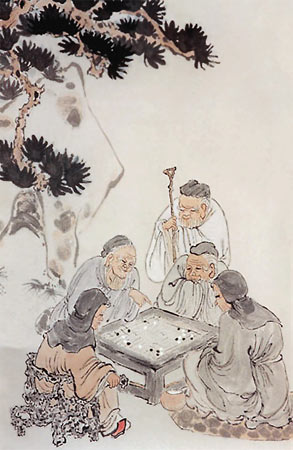
| The Triangle Go Group | Staying Connected for Over 50 Years |

Go, or WeiQi, probably started in China about 4,000 years ago. WeiQi means, literally, the surrounding game. The word Qi is common to many board games in Chinese, such as Guo Ji Chang Qi (International chess) and Zhong Guo Chang Qi (Chinese chess), and Wei means surrounding.
One legend says that Go was created around 2200 BC by Chinese Emperor Yao, to teach discipline, balance and concentration to his son, Danzhu. Other theories suggest that it began as a divination tool, or as a way for warlords to map out battle plans.
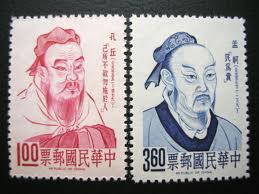 The first known written reference to the game was in 400 BC, referring to an event that occurred in 548 BC. WeiQi was also mentioned in the Analects of Confucius, and in writings by Mencius, who were very important philosophers who lived in China around the 3rd century BC.
The first known written reference to the game was in 400 BC, referring to an event that occurred in 548 BC. WeiQi was also mentioned in the Analects of Confucius, and in writings by Mencius, who were very important philosophers who lived in China around the 3rd century BC.
Go was very popular among the scholars of ancient China. Go was one of the 4 cultivated arts of the Chinese scholar gentleman, along with calligraphy, painting, and playing a musical instrument (qugin). Examinations of skill in those arts was used to qualify candidates for service in the bureaucracy.
Go was well known and widely played in early China. The game was exported to Japan sometime around 800 AD, and it took hold strongly in Japan. Four "Schools" of Go were established in 1602, and each year players from each school would play games to see who would serve as the cabinet-level Minister of Go. There are records of Japanese games dating back to this period, and many interesting stories about strong Japanese Go players through these ages.
Go (Baduk) was known in Korea as early as 475 AD. Today Korea has many of the world's strongest players, and Korea has the highest percentage of any countries' general population that knows how to play the game.
Go faded a bit in popularity by the 19th Century, but in the early 20th Century there was a Go revival in Japan. Many newspapers began sponsoring tournaments, the current Professional Go player associations were established, and the public followed the competitions and the game in daily newspaper and magazine articles. Late in the 20th Century, television channels were dedicated to following the sport. The strongest Professionals were viewed by the Japanese public similarly to how the US views their baseball or football heroes.
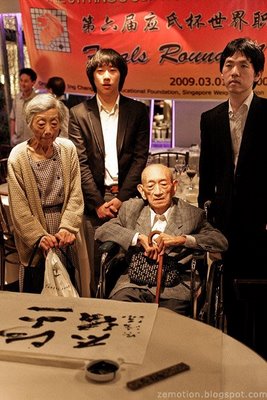 Go continued to exist in China during these years, but it wasn't as wildly popular as it became in Japan until late in the 20th Century. During the cultural revolution in the 1970's, WeiQi was discouraged as a bourgeois pastime, but go players continued playing Go, in secret. One of the West's best known Chinese teachers, Guo Juan 5P, actually learned how to play the game in a re-education camp in the mountains around this time period. She was 8 years old, and saw some grownups playing this interesting looking game, and she persuaded them to teach her how to play. After her family was reunited in her hometown of Chengdu, and her parents realized how much she loved Go, they allowed her to enroll in a Go school when she was 12. Guo Juan went on to become a Professional Go player, and was a member of the Chinese National Go Team in Beijing for many years, before leaving China and moving to The Netherlands.
Go continued to exist in China during these years, but it wasn't as wildly popular as it became in Japan until late in the 20th Century. During the cultural revolution in the 1970's, WeiQi was discouraged as a bourgeois pastime, but go players continued playing Go, in secret. One of the West's best known Chinese teachers, Guo Juan 5P, actually learned how to play the game in a re-education camp in the mountains around this time period. She was 8 years old, and saw some grownups playing this interesting looking game, and she persuaded them to teach her how to play. After her family was reunited in her hometown of Chengdu, and her parents realized how much she loved Go, they allowed her to enroll in a Go school when she was 12. Guo Juan went on to become a Professional Go player, and was a member of the Chinese National Go Team in Beijing for many years, before leaving China and moving to The Netherlands.
Japan was a large influence in reinvigorating WeiQi in China, as they sent a few of their Pros to China to play demonstration games against the Chinese and to teach some of the Chinese players. Many Chinese players had immigrated to Japan in order to play Go, including the man who is called the strongest Go Player of the 20th Century: Go Seigen. Go Seigen's birth name was Wu Qingyuan. He changed his name to Go Seigen after moving to Japan. China restarted their own professional weiqi assocation in 1973, began entering international tournaments, and today some of the strongest players in the world are Chinese.
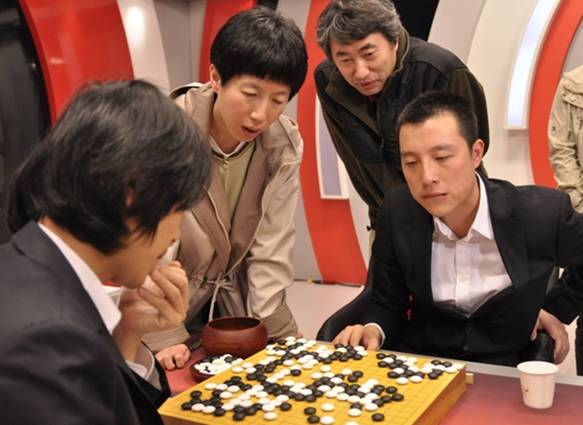
There are many big money tournaments in Japan, China, and Korea. Each of these countries, and others, have Professional Go players and Go schools. More than 30 million Chinese are Go fans, and in Korea, more than 25% of the population knows how to play Go. China, Taiwan, Japan and Korea each have strong Professional Go player associations.
Some of the best Professionals make a very nice living playing Go. In 2010, Lee Sedol, a Korean, earned over half a million dollars in prize money. Many others earned more that $250,000 in 2010. More typical incomes for pros are roughly equivalent to a college graduate's income.
Many major tournaments have been sponsored by commercial entities, such as Ing, LG, Chunlan, Toyota, Fuijitsu, Nongshim, Samsung, many newspapers and television stations, and others.
Go schools exist all over China, and in Japan and Korea, as well. Very few go students go on to become professional go players, but all of the students benefit from studying go.
The rules of the game are simple, and can be learned in just a few minutes. But a serious student of the game can continue learning how to play for the rest of their life.
Go is played on a Go board, which is typically a grid of 19 lines by 19 lines. Beginners may benefit from playing on a 9 x 9 board until they get a good understanding of the game. Usually 2 people play the game, with one person playing the black stones and the other playing the white stones. Black goes first, placing a black stone on one of the intersections of the lines: unlike chess or checkers, you do not place the stones on a square, but on the intersection of the lines. Once a stone is placed on the board it remains there, unmoving, unless it is captured. Captured stones are removed from the board. Play continues with each side taking turns placing a stone until there are no more moves remaining.
Stones are captured when they are completely surrounded. Placing a stone in the center of the board leaves 4 liberties, or avenues of escape. If all 4 liberties are occupied by the opposing player, the stone is captured.
Stones of the same color which are connected are considered to be a group. A group of stones may be captured if all surrounding liberties are filled by the opposing player's stones.
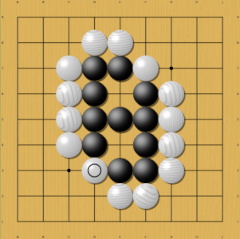 To prevent capture of a group, a group can form a shape which has 2 distinct internal liberties, or empty spaces. Since the opposing player can only play one stone at a time, a group with with 2 distinct internal liberties (called eyes) is alive. (See example at right).
To prevent capture of a group, a group can form a shape which has 2 distinct internal liberties, or empty spaces. Since the opposing player can only play one stone at a time, a group with with 2 distinct internal liberties (called eyes) is alive. (See example at right).
A group with only 1 eye can be captured. The opposing player can surround the group, and then capture them all by placing a stone in the single eye.
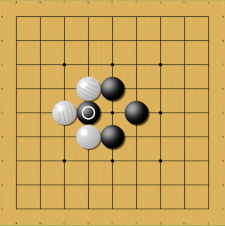 There is a rule called Ko which prevents endless capture/recapture in certain situations (see illustration at left). After the black player captures, the white player must play someplace else before recapturing. If the white player plays elsewhere and the black player also plays elsewhere, then the white player may recapture. And so on.
There is a rule called Ko which prevents endless capture/recapture in certain situations (see illustration at left). After the black player captures, the white player must play someplace else before recapturing. If the white player plays elsewhere and the black player also plays elsewhere, then the white player may recapture. And so on.
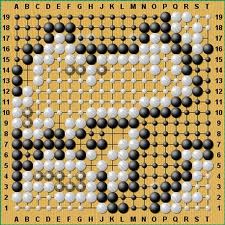 The winner of the game is determined by who ends up with control of most of the board. Using AGA rules, after both players pass, the game is finished. Captured stones are then placed within the opposing players' territory, and the remaining open intersections are counted. Whoever has the most open intersections wins.
The winner of the game is determined by who ends up with control of most of the board. Using AGA rules, after both players pass, the game is finished. Captured stones are then placed within the opposing players' territory, and the remaining open intersections are counted. Whoever has the most open intersections wins.
One final wrinkle: since black moves first, white is given credit for the disadvantage of moving second, by adding "komi" points to their final score. Currently komi in an even AGA game is 7.5 points. So, in an even game (no handicap stones), if the counted points on the board total 40 for black and 35 for white, the end score is black 40 and white 35 + 7.5. Hence, white wins. Handicap games, in which black begins with 2 to 9 stones on the board before play begins, have a komi of 0.5. A "one stone" handicap game is played just like an even game, but with komi of 0.5 rather than 7.5.
Simple, yes?
There is something very special about the attention that the game requires. There is a purity in the focus, something that sometimes occurs when a player is deeply involved in play. As a relatively weak player, I'm still distracted by irrelevant stimuli and lack of knowledge, but I believe that strong players can become so immersed in a game that the rest of the world ceases to exist for them, for a time. I'm not an escapist: I love life outside of the game, enjoy the pleasures and joys inherent in my fortunate existence, and can tolerate my misfortunes. But Go will always engage and intrigue me.
After playing for 30+ years I am still surprised and delighted by the almost magical things that can happen on a Go board. Such a simple game, but even the best professionals continue to find new ways to play. For a game that is possibly 4,000 years old, this is absolutely amazing.